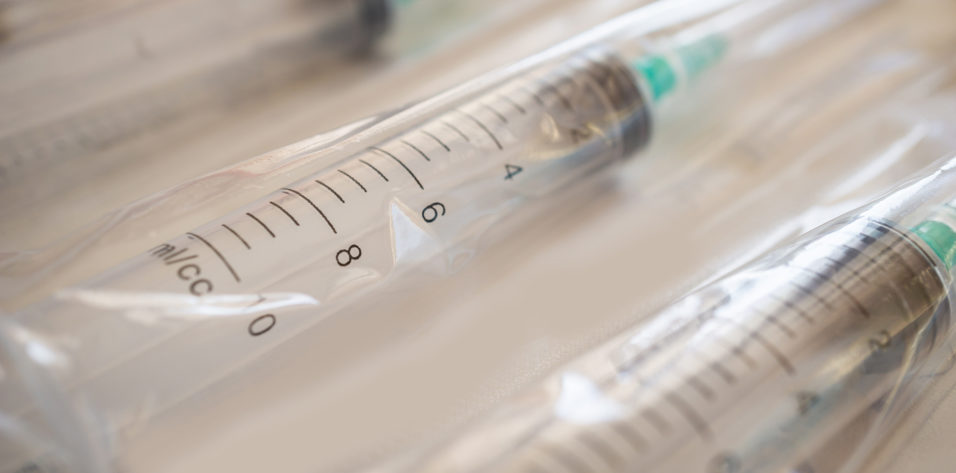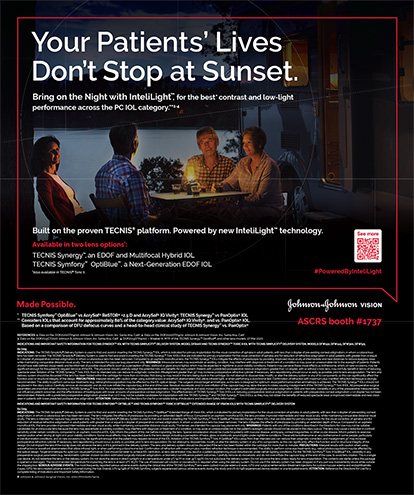You are a refractive cataract surgeon who plans to do cataract surgery on a 58-year-old man with diabetic retinopathy. The patient’s macular OCT shows no significant edema, but it does reveal some microaneurysms and hard exudates. You are concerned that the patient may develop macular edema after cataract surgery. Although referral to a retina specialist is an option, there is no active leakage to treat. What should you do next?
Before 2006, the landscape for macular therapies was quite limited. Patients with macular edema could undergo focal laser treatment, but the laser burns could cause visual scotomas. Some patients with choroidal neovascular membranes had the option of photodynamic therapy, but experience showed that most patients had worsening of vision despite this treatment.
The advent of anti-VEGF therapies brought a sea change, and intravitreal injection of these agents has become the mainstay for the treatment of macular edema and choroidal neovascular membranes. As the population grows and ages, more patients will need these treatments. I believe it is important for cataract surgeons to be familiar with and consider offering these procedures when necessary.
DO IT YOURSELF?
As the efficacy and safety of anti-VEGF therapy became clear and the injections became popular, we referred many patients to our retinal colleagues. Although most patients went without hesitation, many asked whether we could offer the injections ourselves. This gave us pause, and so, in 2011, we began offering anti-VEGF injections. This has been a valuable service to our patients.
For anterior segment surgeons considering offering anti-VEGF injections, I can attest that it is a practice-builder. For others who are not interested in having an injection clinic, I believe it can still be a valuable tool. Consider for a moment the case example described earlier: The patient has several risk factors for developing macular edema after cataract surgery despite a fairly dry macula. I often treat these patients a few times before cataract surgery with an anti-VEGF agent, and then again after surgery to ensure stability. This approach has helped to reduce the risk of postoperative macular edema in high-risk patients.
The literature indicates that anti-VEGF injections are safe with a low risk for complications,1,2 and this has been my personal experience as well. I have performed several thousand injections without complication to date.
There are other important reasons why anterior segment surgeons should be familiar with intravitreal injections. There may be times when we need to work in the pars plana space. Some surgeons perform no-drop cataract surgery, and these antibiotic/steroid mixtures can be injected into the pars plana space just like anti-VEGF injections. When there is a complication during cataract surgery with vitreous loss, the patient may need an anterior vitrectomy, and it’s well known that a pars plana vitrectomy is superior to a limbal vitrectomy with regard to efficacy and efficiency. Instead of injecting a needle, a sclerotomy incision can be made with an microvitreoretinal blade or a 23-gauge trocar placed in the pars plana space. Lastly, anyone who does complex secondary IOL surgery such as intrascleral haptic fixation, Yamane double needle, or glued IOL techniques must be comfortable making incisions around the pars plana space. Therefore, it is important for every anterior segment surgeon to learn to work confidently in the pars plana space.
Beyond complications, the biggest hurdle to overcome in offering this service is the psyche of the patient. When patients are told they need an injection in the eye, a look of dread comes over their faces. It’s important to set the tone with gentle counseling and a positive first experience. If that first injection is traumatic, the patient might not come back.
TOP 10 TIPS
There are certainly many ways to perform high-quality intravitreal injections, just as there are for performing cataract surgery. Here and in an accompanying Eyetube video below, I share my top 10 pearls for anti-VEGF injections, to improve your technique and to enhance the patient experience.
Before getting started, one housekeeping point. Two anti-VEGF agents are FDA-approved and labeled for ophthalmic use: ranibizumab (Lucentis, Genentech) and aflibercept (Eylea, Regeneron). For financial reasons, however, many practitioners choose to use compounded bevacizumab (Avastin, Genentech), an anti-VEGF agent labeled for oncologic use, for intravitreal injection. Studies have shown equivalent visual results with the compounded medication in comparison with the ophthalmic formulations.3
If you choose to use bevacizumab, however, it is important to do your research and choose a reputable compounding pharmacy with a solid track record. Ask your high-volume injection retina colleagues what facility they use. If the pharmacy dispenses a high volume of bevacizumab and many practices use it, it is probably a good choice.
Tip No. 1: Wear a mask. The literature shows that oral flora were the predominant species found in culture-positive endophthalmitis after intravitreal injections.4 For this reason, it is important to always wear a mask during injection procedures. If your injection assistant is going to talk during the procedure, consider asking the assistant to wear one, too.
Tip No. 2: Lidocaine is your friend. We use cotton-tip applicators soaked in 4% lidocaine, applied topically to the injection site. When I first began these injections, some patients would experience pain, but I soon discovered that the key to help minimize pain is firm pressure not only on the conjunctiva but, more important, on the sclera. Applying firm but steady pressure for approximately 5 seconds helps the lidocaine to penetrate beyond the conjunctiva and into the sclera. Two cotton-tip applicators are used consecutively, and each one is applied three times while the cotton tip is rolled to expose fresh lidocaine. With this approach, the patients often don’t even know when the needle is going in. I have tried different methods, including subconjunctival lidocaine injection, and, in my experience, this is the most effective and efficient way to anesthetize the injection site.
Tip No. 3: Use a tuberculin syringe as a marker. I don’t guess where to inject, but I also don’t use calipers. I learned this trick from a retina fellow when I was in training: The hub of a tuberculin syringe has a diameter of exactly 3.5 mm, and it can be used to indent the sclera at the limbus to create a distinct circle as a guide to gauge the correct location for safe injection.
Tip No. 4: Betadine, betadine, betadine. Application of 5% povidone-iodine (Betadine, Avrio Health) on the ocular surface is the only proven method to reduce the risk for endophthalmitis.5 We first paint the periocular skin with 10% povidone-iodine, taking care to scrub the lash line. After retracting the lids, I place a drop of 5% povidone-iodine on the injection site immediately after marking the sclera, which highlights the scleral indentation with a ring of brown.
Tip No. 5: To speculum or not to speculum? I seldom use a speculum. True, there are some patients with such severe blepharospasm that you have no choice but to use one, and the charts of these patients are flagged to tell us to use a speculum. But these patients are the exception and not the rule. In my experience, patients feel more discomfort with the speculum, as the pressure sensation worsens when the patient squeezes against it.
I prefer to use my fingers as a speculum to retract the eyelids. I have better control of the amount of tension I’m putting on the lids, which results in a more comfortable experience for the patient. I have quite a few injection patients who moved to our area from elsewhere, and, when they have their first injection with me, they are often surprised by how easy and painless it was compared with their previous experience. For the right patient, the finger-speculum technique can be the difference between a bad experience and a good one.
Tip No. 6: Stay on target. If you don’t give the patient something to look at, he or she might suddenly move while you’re placing the injection, which can be dangerous. I perform these injections in the lanes, and I recline the chair to roughly a 150° angle. I stand to the right side of the patient at eye level, and the assistant stands next to me at the patient’s knee level. For right eyes, I have a fixation target X on a gooseneck lamp stand that is to the patient’s left. The patient looks down and to the left at the X target to expose the superotemporal conjunctiva for the right-eye injection. For left eyes, I have the patient look inferonasally toward the technician, who is standing on the right. This serves two important purposes. First, it keeps the eye steady during the entire procedure; second, it helps to focus the patient on a task that distracts from the injection.
Tip No. 7: Play music. Using my fingers is more comfortable than a metal speculum, and providing a fixation target helps to steady the patient’s eye, but music is another important way to relax and distract the patient from the injection. Not all patients like when music is playing in the lane, but most do. Music has become easily accessible from our smartphones, and I start playing it when we are getting ready. As long as the music is not too loud to interfere with communication with the assistant, it is an effective way to calm the patient.
Tip No. 8: Talk. The terms verbal anesthesia and vocal local are commonly used in cataract surgery. This simply means that you talk to the patient in order to take his or her mind off the surgery. It is an effective tool for injections as well.
Tip No. 9: Take a deep breath. During the entire injection procedure, I’m talking to the patient and reminding him or her to fixate on the target. But, right before the injection, I’ll ask the patient to take a deep breath. Having the patient focus on the deep breath distracts him or her as the needle goes in. Often, patients don’t even feel it. Over time, however, patients can get wise to these tricks, so you may need to devise new strategies.
Tip No. 10: Be flexible. Some patients are just too tense, no matter what you try. If necessary, valium can be helpful. If the patient has severe blepharospasm, use a speculum. If the patient is unable to look inferonasally at the target due to a particularly strong Bells reflex, move the fixation target above the patient’s eye, let the patient fixate upward, and inject inferiorly. You can pick different sites depending on the patient’s needs.
Some require even more creative strategies. I have a patient who lives with chronic pain. She she would yelp and cry when I first did her injections. I was worried that she would need conscious sedation. But I soon learned that her late husband was a ballroom dancer, and that a specific song reminded her of dancing with him. When I played that song right before the injection, it instantly took her back to those memories and relaxed her. Not always, but often, she wouldn’t even feel the needle. Sometimes you just have to get creative and develop new strategies to help patients.
CONCLUSION
Injecting needles into the eye can be scary for patients, but, by following good technique and offering simple strategies to help to calm the patient, you can provide a safe, efficacious, and comfortable patient injection experience.
1. Moshfeghi AA, Rosenfeld PJ, Flynn HW Jr, et al. Endophthalmitis after intravitreal vascular [corrected] endothelial growth factor antagonists: A six-year experience at a university referral center. Retina. 2011;31(4):662-668.
2. Jager RD, Aiello LP, Patel SC, Cunningham ET Jr. Risks of intravitreous injection: A comprehensive review. Retina. 2004;24:676-698.
3. Chen G1, Li W, Tzekov R, Jiang F, Mao S, Tong Y. Bevacizumab versus ranibizumab for neovascular age-related macular degeneration: a meta-analysis of randomized controlled trials. Retina. 2015;35(2):187-193.
4. McCannel CA. Meta-analysis of endophthalmitis after intravitreal injection of anti-vascular endothelial growth factor agents: causative organisms and possible prevention strategies. Retina. 2011;31(4):654-661.
5. Ciulla TA, Starr MB, Masket S. Bacterial endophthalmitis prophylaxis for cataract surgery: an evidence-based update. Ophthalmology. 2002;109(1):13-24.





